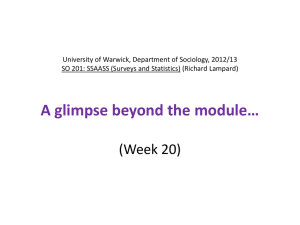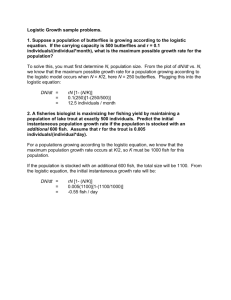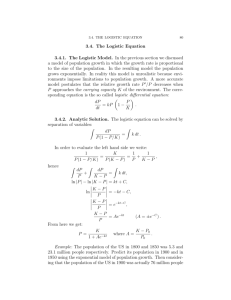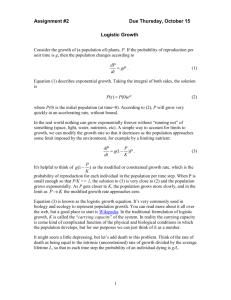Section 2.3: More Population Models
advertisement
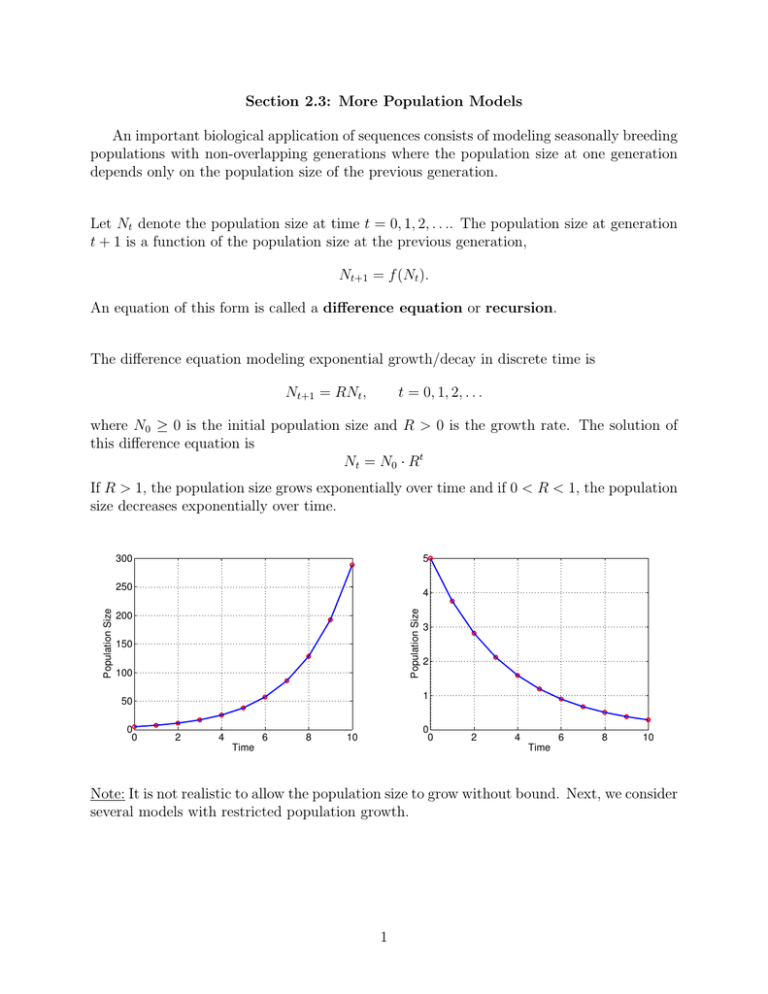
Section 2.3: More Population Models An important biological application of sequences consists of modeling seasonally breeding populations with non-overlapping generations where the population size at one generation depends only on the population size of the previous generation. Let Nt denote the population size at time t = 0, 1, 2, . . .. The population size at generation t + 1 is a function of the population size at the previous generation, Nt+1 = f (Nt ). An equation of this form is called a difference equation or recursion. The difference equation modeling exponential growth/decay in discrete time is Nt+1 = RNt , t = 0, 1, 2, . . . where N0 ≥ 0 is the initial population size and R > 0 is the growth rate. The solution of this difference equation is Nt = N0 · Rt If R > 1, the population size grows exponentially over time and if 0 < R < 1, the population size decreases exponentially over time. 300 5 4 Population Size Population Size 250 200 150 100 2 1 50 0 0 3 2 4 6 8 0 0 10 Time 2 4 6 8 10 Time Note: It is not realistic to allow the population size to grow without bound. Next, we consider several models with restricted population growth. 1 The Beverton-Holt Model The Beverton-Holt model is given by the difference equation Nt+1 = RNt 1 + R−1 Nt K where R > 1 is the growth rate and K > 0 is the carrying capacity of the population. Example: Find all equilibria of the Beverton-Holt model and discuss their stability. R=1.5, K=20 35 Population Size 30 25 20 15 10 5 0 0 5 10 Time 15 20 2 The Discrete Logistic Model The discrete logistic model is given by the difference equation Nt Nt+1 = Nt 1 + R 1 − K where R > 0 is the growth rate and K > 0 is the carrying capacity of the population. Example: Find all equilibria of the discrete logistic model and discuss their stability. R=1.9, K=20 R=2.5, K=20 35 30 30 30 25 25 25 20 15 10 20 15 10 5 5 0 0 0 0 5 10 Time 15 20 Population Size 35 Population Size Population Size R=0.5, K=20 35 20 15 10 5 5 10 Time 3 15 20 0 0 5 10 Time 15 20 Note: The discrete logistic model can be simplified by rewriting the difference equation in canonical form. The canonical form of the discrete logistic model is xt+1 = rxt (1 − xt ) R where xt = K(1+R) Nt and r = 1 + R > 1. The advantage is that this difference equation is simpler, involves only one parameter, and the variable xt ∈ (0, 1) is dimensionless. Example: Find all equilibria of the canonical form of the discrete logistic model and discuss their stability. Note: If the initial population size and growth rate are not restricted, the discrete logistic model may result in negative population sizes. 4 The Ricker Logistic Model The Ricker logistic model is given by the difference equation Nt Nt+1 = Nt exp R 1 − K where R > 0 is the growth rate and K > 0 is the carrying capacity of the population. Example: Find all equilibria of the Ricker logistic model and discuss their stability. R=0.5, K=20 R=1.9, K=20 35 35 30 30 25 25 R=2.8, K=20 50 20 15 10 Population Size Population Size Population Size 40 20 15 10 30 20 10 5 0 0 5 5 10 Time 15 20 0 0 5 10 Time 5 15 20 0 0 5 10 Time 15 20
